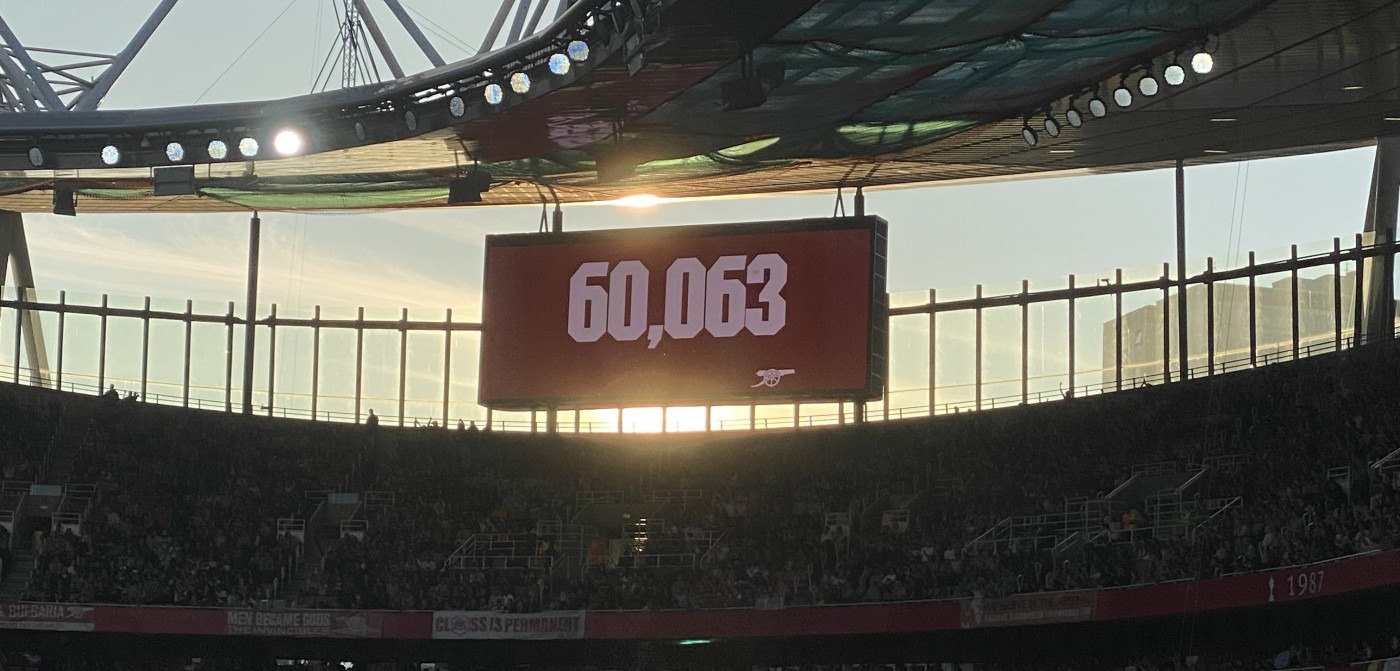Moving on up: How ‘men’s’ football stadiums have become the home of women’s teams too
The 23/24 women’s football season has seen a plethora of big crowds, record-breaking attendances, and sold-out stadiums, proving that the women’s game is growing exponentially.
Visibility was birthed off the back of the World Cup in the summer of 2023, where England made it to the final. This sat on the shoulders of the massive growth of the game after the Lionesses brought home the European Championship trophy on home soil at a sold-out Wembley the year before.
Arsenal Women set the Barclays Women’s Super League (WSL) attendance record in February when they brought a sell-out crowd of 60,160 to the Emirates. This beat the previous record, which they had set earlier in the season, of 59,042 at the Emirates. Arsenal also saw an impressive crowd of 54,115 against Liverpool on 1 October, showing a new level of consistency.
This meant that Arsenal Women’s 23/24 season saw an average attendance of 53,871 at the Emirates; however, matches at their far smaller Meadow Park ground bring down the average for the whole season – all matches considered, their average attendance sits around 31,000.
This figure places them above 10 Premier League men’s clubs which is testament to the growth of the women’s game. This also fuels the argument that the Gunners are ready to permanently move away from Meadow Park, where the capacity is only 4,500. It has now been announced that Arsenal Women will play 11 games at the Emirates next season, making it their main home ground. This powerfully changes the narrative that the Emirates is the ‘men’s’ stadium, with the stadium now accommodating the women’s side on a far more consistent basis.
The Lionesses are now accustomed to filling the stands of Wembley time and time again
The Womens Continental Tyres Cup also saw a record attendance this season. The final between Arsenal and Chelsea saw 21,462 fans travel to Wolves’ Molineux stadium. The Women’s FA Cup Final historically sold-out Wembley with a crowd of 76,082.
In the UEFA Champions League, Chelsea WFC saw the selling out of their men’s home stadium, Stamford Bridge, when facing Barcelona in the semi-final. This was the first sell-out for Chelsea’s women’s team across all leagues; their attendance on the night sat at 39,398.
It’s not only domestic football that has seen its attraction increase, but also international football.
In the April international break, England’s Lionesses played Sweden at Wembley Stadium with the attendance standing at 63,248, despite industrial action on the day. This was held a year on from the first women’s Finalissima, where a crowd of 87,192 watched the Lionesses lift the trophy at the home of the national team. The Lionesses are now accustomed to filling the stands of Wembley time and time again.
The Barclay’s WSL has recently announced that the 23/24 season has been record-breaking for accumulative attendances; domestic league attendances have surpassed one million across the Barclays WSL and Women’s Championship this season.
Furthermore, growing attention for the game is not only evident in stadiums; Sky Sports have too reported record viewership. With more fans than ever tuning into women’s football at home and a record amount watching in person, it cannot be denied that the game is going from strength to strength. This growth has been rewarded with a record £9 million Barclays sponsorship deal in place for the 24/25 season, allowing more games than ever to be shown on television.
However, when it comes to thinking about the sustainability of the growth of the game, as well as increasing attention of all major women’s teams, pricing strategy, supporter’s groups and stadiums are also key focuses.
The women are playing at ‘men’s’ stadiums but bringing in big enough crowds to make them justifiably their own stadiums too
It’s evident that Arsenal Women are trailblazers in the women’s game in this regard. Their success is down to specific strategies the club have implemented.
Arsenal created ‘home advantage packs’ this season, of which they sold 12,000. These packs were exclusively for their five Emirates games. This meant that a consistent base crowd was secured for these games, creating an aspect of loyalty and community in the larger stadium.
Furthermore, the club have been praised for their tiered pricing structure. This incentivises early purchases and has increased ticket sales. Jonas Eidevall, Arsenal’s manager, has stated that the club’s top ambition is to “accelerate the growth of women’s football”, and that this “is influencing every decision”.
He followed on, it “is very important, to start with that, to make it a real investment. What I think makes Arsenal special – the belonging in the community and the connection to the fans – I think it’s one of those things that if you could bottle that and sell it you would probably end up earning a lot of money.” The club’s actions are an example to other clubs on how to fill their ‘men’s’ stadiums.
The women’s game is gaining sustainability; it’s growing in popularity and yet is managing to create its own image. The women are playing at ‘men’s’ stadiums but bringing in big enough crowds to make them justifiably their own stadiums too.

Comments